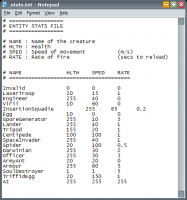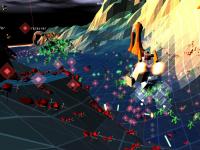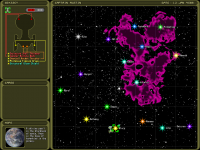Making a traditional, full-fat mod is not a one man task. Simply juggling coding, modelling, mapping, texturing, advertising, webmastering and the gameplay design itself is nigh on impossible; and even if you do manage it, there is the none-too-small problem of being talented enough in each area to reach a reasonable level of quality. If you want to go it alone, you are best to focus on one or two aspects and dump the rest, or else have an incredible breadth of knowledge and plenty of patience.
This is where indie games step in. You might still consider them petty little things, or perhaps lump them with casual games as something real gamers aren’t interested in, but mark my words: they are only just warming up. Indies games stand every chance of becoming an enormously important part of the PC market, but more importantly to you and me provide everything you need to realise your designs quickly and efficiently. There are advantages and disadvantages to indie modding, of course, and these are what we are going to be looking at before delving into some specific examples of where to get started.
Pros and Cons
The simplicity of indie games is their most immediate plus. Their mods tend to need very little in the way of content creation; it’s more a case of rearranging what’s already there. Any content that does need to be made is usually very simple, in the order of 2D image manipulation or the copying of sound effects from other titles.
Code, too, is watered down. Those indie games that support mods are almost always built with a pre-compiled core on which scripts run to determine gameplay. scripting isn’t necessarily a piece of cake, but is still a far cry from the complexities of C++, and can often be achieved by copying and tweaking existing examples from the parent game itself. Another nice bonus is not needing an expensive compiler – just Notepad.
That might all be attractive, but take note that simplicity can go too far. The tools for creating indie mods are typically poorly documented and sometimes don’t even exist, requiring you to instead fiddle around with scripts for map design and other tasks that would normally be handled by GUI-driven tools like Hammer or Radiant. If you want to make complex content you might even find the situation reversed, with major engines turning out easier. The lack of access to code of any real description means you shouldn’t bank on being able to diverge too far from the game’s original genre – in fact you might even find that some of what you saw in the game was hacked into the code when the script system proved inflexible (they aren’t called indie for nothing!). To put things bluntly, you have no real guarantee that an indie game will allow what you are trying to achieve when you start.
Your audience is another double edged sword. Indie games attract a more focused, more mature, and more involved community than Counter-Strike and its peers, but at the same time a far smaller one. If you want to make games because you love making games, the indie scene is where it’s at. If you want to make games to break in to the mainstream professional industry on the other hand, you’ll likely find yourself treading a path that while not useless (especially if your aim is a ‘proper’ mod team) is certainly inefficient. Expect useful feedback and genuine appreciation, not worldwide gaming fame and towering download figures.
Which brings us on to one pro without an associated con. That indie mods are tiny. If you aren’t adding new content they can easily be below 40 or so kilobytes, well within the ‘impulse download’ range for all connection speeds and unless everyone in the Western world downloads the installer, far below any bandwidth limitations.
Compared to their mainstream brothers, indie mods are quick and easy to develop, rewarding to release, cheap to host, and a potential gateway to the larger mod teams. All we need is somewhere to start...
Darwinia (Introversion Software, 2005)
Homepage: www.darwinia.co.uk
Demo: www.darwinia.co.uk/downloads/index.html (does not load mods)
ModDB Review: Read it now!
Mod Downloads: ModDB; Stellar Matter; TheNextGame
Darwinia presents an interesting compromise between indie and mainstream technology, something best summed up by Introversion use of the game’s full-3D engine to display untextured, low-poly models and simple two-dimensional sprites on largely barren worlds. The style has the great advantages of looking gorgeous and being easy to reproduce, at all levels, for the cost of what little versatility indie games usually have. This restrictiveness follows on to gameplay, which doesn’t allow anything beyond stat tweaking. You might even go so far as to say that you can’t really mod Darwinia, only make mission packs. Fortunately, the scripting system lets these ‘mission packs’ play very differently from the parent game indeed. Download ArcadeRemix for an example of just how far the game can be stretched.
Darwinia only has one mod tool, a map editor, which is unlocked when you complete the game. There is no official guide for its use but fansite TheNextGame have a comprehensive tutorial for making a mod from start to finish, in which the editor is the central point: map design and in-game events are handled through it, with a drop back to scripts only for changes to the built-in entities and typing event text (for localisation reasons).
There’s only one way to get a truly reliable impression of modding Darwinia though. We spoke to Nihilesthetics, creator of the titular Nihils’ Darwinia Modding Pages:
“I’m not one for modding much. In fact most of my games get played once and then get relegated to the back of the cupboard to gather dust. Yet even 8 months after buying Darwinia, I’m still very much involved thanks to the game’s modding scene. If you dive into the editor, its not hard to see why. A few minutes and you have a landscape to your specification with all your buildings and units deployed. Anyone can create a simple level with a couple of dozen clicks of the mouse. The initial simplicity may hook you in, but it also belies a real depth of features that takes time to master and keeps you coming back. Your entire mod is described with a series of configuration and script files that you can manually edit for greater control. There is no programming required, just a simple configuration syntax of maybe thirty or so commands and parameters. You can even include your own textures, sounds and models simply by dropping bitmaps, .OGG samples, etc. into the appropriate folders.
A small, indie developer like Introversion could be forgiven for cutting corners with the modding tools, but instead they have really put time into creating a modding system that’s fun to use. They even released the original 3D models for the modding community to experiment with.
There are a few issues, however. Although you can change the graphics and sounds of the various building types and units, you can’t really change their behaviour or create new ones. That’s the flipside to having a nice, simple modding engine. Also, Darwinia’s existing gameplay style has been more or less exhausted with the current crop of mods. You will find you have to work hard to persuade the game to move beyond it’s default genre, but to create something truly original that’s to be expected. I’m looking forward to some puzzle/adventure/strategy elements coming through.
All in all, modding Darwinia is a fun pastime and you don’t have to be a programmer to do it.”
Strange Adventurs in Infinite Space (Digital Eel, 2002)
Homepage: Digital-eel.com
Demo: Digital-eel.com (does not load mods)
Reviews: GameSpot; PC Gameworld; The Underdogs
Mod Downloads: Digital Eel’s mod directory
Darwinia was an example of a transitional indie game with a comparatively strong mod background, built in tools and active community. Our next study, Strange Adventures in Infinite Space, is quite different. A niche product with no official community hub (The SAIS Federation fills the gap, for those who find it), no box on store shelves, little press coverage and mod support only since the 1.2 patch, Strange Adventures might seem like a lost cause on the modding front. Not so. In fact, there are more mods for SAIS than there are Darwinia. Why? Because it’s so damn easy.
This is principally because of the nature of the game’s content. You might be able to hammer out a modified Squad in Darwinia in a minute or two, but it isn’t going to be very interesting if you are using it in the same areas as the main game; in fact it will probably degrade the gameplay. You need to make your own islands to get anything done and doing so is extremely time consuming. SAIS is a blessing in this regard, smashing the entire problem with an entirely randomised playing field. This, combined with the very short nature of each game, lets you make changes and see their effects incredibly quickly, a technique known as rapid prototyping which works wonders for design - and quite aside from making development faster, having iterations every few minutes makes modding just as responsive and engaging as playing!
The upshot of all this is that SAIS needs no built-in tools, and indeed Digital Eel provide none save a quick program to unpack the game’s files. Notepad and MS Paint (for replacing any of the 64x64 8-bit graphics) are all a modder will ever have to use. It all sounded too good to be true, so we got in touch with the SAIS mod community to find out what was really going on...
“My name is Jeremy, and I created the mod Even Stranger Adventures in Infinite Space. When I first purchased SAIS, I tinkered around a bit with the sample mod Digital Eel provided to show what could be done. Then I started poking into the game data files and realized that all I had to do to mod this game was edit a few text files and add a little artwork. It's simple enough that I created my first massive mod before I ever even went looking for a modding community. The community is small, but there are a couple of people who have made good mods, and at least one of them, Exaar, seems to be ever-present and willing to offer advice.
Part of the fun of modding this game is that it's not only really easy to do once you've figured out what all the parameters control, but you're also somewhat limited in what you can do. It sounds strange that a limitation makes the game more fun to mod, but it's true. I ended up tweaking parameters to get essentially the same weapon effects to behave very differently. If you look at my Concussion Missile and my Singularity missile, they are essentially identical, though they have dramatically different effects on gameplay. And sometimes the lack of a parameter reference cause strange weapon effects that I decided to incorporate into my mod. The Tau Particle Cascade showcases this.
Another good thing about modding this game is that you can change the entire original game, or keep everything and just add to it. I opted for the latter. I tried to improve on a few things like the stars and starting ship designs, but I wanted to keep all the enemies and weapons of the original game, and just add more.
There were a few obnoxious elements to modding this game. The first was the lack of an ability to add encounter screens for new enemy fleets. Other things like an inability to arrange the fleets, and a three ship limitation per race were walls I kept running into as well. But, the primary source of annoyance when modding SAIS is finding the right sound to go with anything. It can take as long to find the right sound as it took to make all the artwork for a weapon, edit all the relevant text files, and test the functionality. In fact, I know of at least three weapons in my mod where I got sick of looking for the right sound, and just went with an acceptable one.
Modding this game has been a blast though. There is only a smattering of documentation to get you started, but once you've figured things out, it's not hard. Unlike most other games, the SAIS modder needs only creativity and a sense of balance; almost no technical knowledge is required.”
Conclusion
Reading the testimonials on the last two pages, you might think they are written by the same person. They aren’t of course – their similarities instead provide a good example of the qualities shared across the board by indie titles. We’ve seen how modding indie games is quick and easy with great results, how strong their small communities can be, and more than anything else how fun it is. You won’t spend months cajoling a team into producing their first alpha here: you’ll instead have something playable within minutes.
Fast, fun, friendly and occasionally frustrating, indie mods are only going to remain a curiosity until you decide to do something about it. And even if you don’t end up modding them, both of the games in this feature are well worth their meagre asking price. It’s an offer you can hardly refuse!






Not such a far cry from my first experience in Modding. A text editor for units of C&C Red alert. That's probably the first evidence of me wanting more, something more sculpted, something more defined. I loved that text editor, it couldn't have been more simple. A hugely popular thing was giving the V2 rockets nuclear warheads. But I spent weeks after that perfecting all the other units of the game to fit around this dangerously potent low tech unit. I edited the character units from the singleplayer, putting generals who fired silenced mig rockets with flame damage into multiplayer. It wasn't logical, but it was freedom. And with that freedom (as far as I was concerned) there had to be rules.
I tried to balance everything so I could splay skirmish battles that didn't just end up in tank rushes. I edited units so that you had cheap responses to threats the enemy might throw at you. I even improved the naval vessels so the computer seemes more inclined to use them. Those were good times. If I think about trying to code for HL now my head explodes. GJ Darwinia.
I did a similar thing. My RA mod reintroduced infantry past the first few missions. It was loads of fun and oh so easy & rewarding. :)